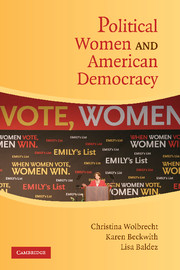Book contents
- Frontmatter
- Contents
- Preface
- List of Contributors
- Political Women and American Democracy
- 1 Introduction: What We Saw at the Revolution: Women in American Politics and Political Science
- 2 Gender as a Category of Analysis in American Political Development
- 3 Gender, Public Opinion, and Political Reasoning
- 4 Gender in the Aggregate, Gender in the Individual, Gender and Political Action
- 5 What Revolution? Incorporating Intersectionality in Women and Politics
- 6 Women's Movements and Women in Movements: Influencing American Democracy from the “Outside”?
- 7 Representation by Gender and Parties
- 8 Women as Candidates in American Politics: The Continuing Impact of Sex and Gender
- 9 Women as Officeholders: Linking Descriptive and Substantive Representation
- 10 Theorizing Women's Representation in the United States
- 11 Political Women in Comparative Democracies: A Primer for Americanists
- 12 Conclusion: Between Participation and Representation: Political Women and Democracy in the United States
- References
- Index
10 - Theorizing Women's Representation in the United States
Published online by Cambridge University Press: 05 September 2012
- Frontmatter
- Contents
- Preface
- List of Contributors
- Political Women and American Democracy
- 1 Introduction: What We Saw at the Revolution: Women in American Politics and Political Science
- 2 Gender as a Category of Analysis in American Political Development
- 3 Gender, Public Opinion, and Political Reasoning
- 4 Gender in the Aggregate, Gender in the Individual, Gender and Political Action
- 5 What Revolution? Incorporating Intersectionality in Women and Politics
- 6 Women's Movements and Women in Movements: Influencing American Democracy from the “Outside”?
- 7 Representation by Gender and Parties
- 8 Women as Candidates in American Politics: The Continuing Impact of Sex and Gender
- 9 Women as Officeholders: Linking Descriptive and Substantive Representation
- 10 Theorizing Women's Representation in the United States
- 11 Political Women in Comparative Democracies: A Primer for Americanists
- 12 Conclusion: Between Participation and Representation: Political Women and Democracy in the United States
- References
- Index
Summary
From the perspective of women's experiences, it is easy to see that democratic representative institutions can be tools of oppression. After all, formal democratic institutions have been either a form of governance that has only ruled over women (e.g., women were formally prohibited from holding elected offices) or a form of governance in which women have ruled and been ruled unequally (e.g., the number of female representatives have been significantly lower than the number of male representatives). Moreover, there is good reason to believe that informal representative institutions, such as interest groups, do not work as well for multiply disadvantaged groups (Strolovitch 2007). These facts suggest that democratic representative institutions need to be viewed with suspicion. We need to know why democratic representative institutions do not work for women as well as they work for powerful men, and we need to know what conditions contribute to those institutions working better for women. We also should not assume that representative institutions in democracies necessarily benefit all women. In fact, we need to recognize how representative institutions can divide women, pitting some women's interests and preferences against other women's interests and preferences. Democratic representative institutions can function to preserve the status quo, distributing benefits unjustly and inequitably among different groups of women.
Knowing if and how well representative institutions are working for women in democracies depends, in part, on one's understanding of what counts as the adequate representation of women in a democracy. Does the adequate representation of women require female representatives?
- Type
- Chapter
- Information
- Political Women and American Democracy , pp. 148 - 166Publisher: Cambridge University PressPrint publication year: 2008
- 4
- Cited by



